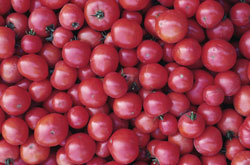Lycopene extracted from tomato waste
In Europe, a staggering 8.5 million tons of tomatoes are grown every year and, after processing, more than 2 million tons of material will be waste. This residue is still an excellent source of neutraceuticals and food supplements, including the important antioxidant lycopene. Partners of the TOM project have developed an extraction process whereby lycopene is extracted in tomato seed oil from tomato plant processing residue. This can then be used in functional food products and cosmetics. The process, carried out on an industrial scale, involves the use of supercritical carbon dioxide (CO2). Carbon dioxide, compressed beyond its supercritical point develops substantial solvent power. Ethanol was added as a co-solvent. The project partners have defined the optimal temperature and pressure conditions for the extraction operation. The extract is then isolated using centrifugation to obtain oil in the lowest fraction. The resulting oil can be subject to oxidation and to avoid this, 0.1 % Vitamin E is added. Furthermore, by extracting the middle fraction after the centrifugation process, the lycopene can be obtained in wax. This product has multiple applications in the cosmetics industry including use as a natural colourant and an anti-oxidant in skin care products. This development provides the opportunity to obtain a high-value product from the tomato processing industry's waste. Benefits derived will be reduced production costs together with improved organic products and prices for the consumer.



